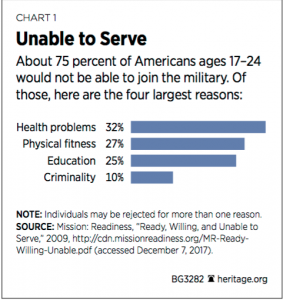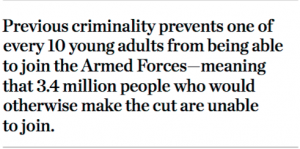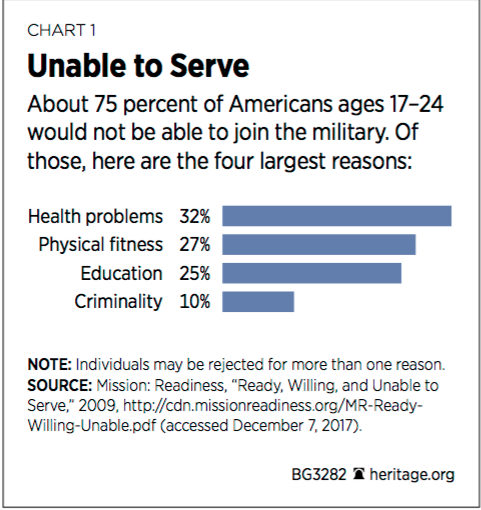
The military depends on a constant flow of volunteers every year to meet its requirements, and as the number of eligible americans declines, it will be increasingly difficult to meet the needs. This is not a distant problem to address decades from now. The U.S. military is already having a hard time attracting enough qualified volunteers. Of the four services, the army has the greatest annual need. The army anticipates problems with meeting its 2018 goal to enlist 80,000 qualified volunteers, even with increased bonuses and incentives.
Even more than on planes, ships, and tanks, the military depends on ready and willing American volunteers to protect this nation. In a recent panel discussion on this looming crisis, army Major General Malcolm Frost, the commander of the army’s Initial Military Training Command said, “I would argue that the next existential threat we have…is the inability to man our military.” In 2009, a group of retired U.S. generals and admirals formed a nonprofit group, “Mission: readiness” to draw attention to this growing problem. In their report “Ready, Willing, and Unable to Serve,” they report that the main causes of this situation are inadequate education, criminality, and obesity. Unchecked, the combined effect of these three conditions will continue to decrease the number of young adults eligible to serve in the United States military.
The issue of growing ineligibility for military service among America’s youth must be a national priority. The former commander of the Marine Corps recruiting Command, Major General Mark Brilakis, says, “There are 30 some million 17- to 24 year-olds out there, but by the time you get all the way down to those that are qualified, you’re down to less than a million young Americans.” A manpower shortage in the United States military directly compromises national security. America needs a strong military to defend its national interests, and that military depends on qualified volunteers. As the most recent U.S. National Security Strategy makes clear,
“The United States faces an extraordinarily dangerous world, filled with a wide range of threats that have intensified in recent years.”
Greater numbers of Americans could be available if the military lowered its standards, but this would also arguably put the nation’s defense at risk since the caliber among service members would be reduced, harming a qualitative factor that has always represented a competitive advantage of the U.S. military. reinforcing this point, the army’s current recruiting commander, Major General Jeffrey Snow, said: “We don’t want to sacrifice quality. If we lower the quality, yes we might be able to make our mission, but that’s not good for the organization. The American public has come to expect a qualified army that can defend the nation.” He adds, “I don’t think the American public would like us to lower the quality of those joining the army if they knew it’s going to impact our ability to perform the very functions our nation expects us to do.”
This same sentiment applies to the other branches as well. “This is not just an army problem,” seconds retired Lieutenant General John Bednarek,
“It’s not even a joint problem of all the services. This is a national issue tied to the security of the United States of America.”
Thus, the remedy to this national dilemma must be to address those staggering numbers who do not qualify, and put in place programs to reverse these trends.
Education
To join the armed forces, the military across all branches requires that an individual have a high school diploma or a General Equivalency Diploma (GeD).
This qualification ensures that recruits possess a minimum level of education, a basic understanding of written and cognitive skills, and enough “stick-to-itiveness” to complete an organized pro- gram. This basic standard eliminates far too many young americans from being able to serve. Though comparable ineligibility statistics from past years do not exist (the military only recently started calculating ineligibility percentages), “experts said seniors graduating from high school [in 2014] faced the longest odds to qualify for military service since the draft was abolished in 1973.
Despite the National Center for education Statis- tics (NCeS) reporting that in the 2014–2015 school year, “the adjusted cohort graduation rate (aCGr) for public high school students rose to 83 percent,”11 dropout expert Julian Vasquez Heilig says that “the only people who believe it’s [over] 80 percent are probably the politicians who are telling us that.”12 In addition to other shortcomings, this statistic from the NCeS does not account for lowered graduation standards, incomplete data, or the students who transferred to other programs (typically those most at risk of not graduating).13
Graduation rates reported by major U.S. cities tell a more accurate and depressing story, with places like Montgomery, alabama, reporting 70.7 percent and albany, Oregon, as low as 51.3 percent.14 Chi- cago, Illinois, measures its graduation rate based on a ve-year program, and as of 2016 was only at 73.5 percent.
For those who do not complete high school, the military accepts a certain number of recruits who have received their GED, but these individuals rarely pass the armed Forces Qualification Test (AFQT). Among other things, the AFQT measures recruits’ math and reading skills upon application to the military. Young Americans’ inability to meet education qualifications highlights underlying issues in America’s educational foundations, with national consequences.
Criminality

Another hindrance to young adults’ ability to join the military is criminal history. Though each branch’s criminal-background requirements vary slightly, the Armed Forces jointly adhere to a common standard of moral behavior as a means of evaluating a recruit’s ability to succeed in military service. Across the Services, emphasis is placed on conviction of a crime, not so much on the punishment given. Criminal history is relevant because it shows recruiters the kind of behavior and activities that recruits have exhibited in the past—which, while not predictive, certainly hint at the potential for similar behavior in the future. Depending on the seriousness of the infraction, the Services determine whether a potential recruit with a criminal record poses too great a liability. Across the branches it is widely emphasized that people do not have an absolute right to serve in the United States military rather, military service is a privilege, and thus necessitates a certain level of societal regard and good behavior.
According to the 2009 Mission: readiness report, criminality prevents one of every 10 young adults from being able to join the armed forces. That means that 3.4 million people who would otherwise make the cut are unable to join.
Disqualifying crimes are various and include felonies or serious misdemeanors. Addition ally, the military has low tolerance for recruits demonstrating consistent use of illegal or recreational drugs or contributing to their distribution. In 2016, a third of Americans ages 18 to 25 had used marijuana within the past year, and over 50 percent within their lifetime.
The opioid epidemic—widely reported by the media, and declared by both President Trump and members of both political parties in the U.S. Congress in mid-October 2017 to be a public health emergency—predominantly occurs among that same age group.
Other situations that disqualify recruits from service are sexual offenses, repeated convictions of drunk driving and similar infractions, and being on probation. Trends in criminal activity among youth can be affected by education programs, with good programs leading to a decrease in criminal behavior and poor programs worsening the problem.
Kids engaged in well-managed academic and extracurricular activities are less likely to commit crimes than their counterparts. Nationwide organizations like the Boys & Girls Clubs of America, which provide after-school community-center activities for children of all ages, report successes on multiple fronts.
Health Issues
According to the former Commander of the U.S. Army Recruiting Command, Major General Allen Batschelet, the biggest culprit keeping young adults from qualifying to serve in the united States military is health concerns, mostly obesity.
In 2015, he stated: “The obesity issue is the most troubling because the trend is going in the wrong direction…. by 2020 it could be as high as 50%, which means only 2 in 10 would qualify to join the army.”
The Air Force’s recruiting commander, Major Gen- eral Garrett Harencak, adds: “We have a problem with obesity in kids.” The Mission: readiness report previously cited reports that “27% of young americans are too overweight for military service,” and of the total number of those who attempt to join the Armed Forces, approximately 15,000 are rejected every year because they are overweight.
These statistics are likely to climb. Based on data from the National Health and Nutrition examination Survey, one in three adults is obese, as are one in six children and adolescents between ages two and 19. Trends show growing numbers in the coming years. The Trust for America’s Health reports that in 2006, Mississippi was the only u.S. state with an adult obesity rate above 30 percent. Today, 30 states can claim that dubious honor.
Recommendations:
The Executive Branch should:
- Initiate an integrated and comprehensive public awareness and advocacy program to promote awareness of the problem of the inability of young Americans to qualify for basic military service. The executive branch should actively seek appropriate role models to help promote this campaign; and
- Promptly appoint leading influential role models to serve as chairmen and members of the President’s Council on Fitness, Sports & Nutrition, and direct them to develop a plan with specific outcomes to reverse the downhill fitness trend.
Congress (as it pertains to military-connected children) and the states (universally) should:
- Establish commonsense school choice options that enable parents to place their children in schools of their choice.
Congress, states, and local government should:
- Support programs, such as Junior ROTC (managed by the Department of Defense), Scouting, Big Brother–Big Sister, and youth sports, in order to provide healthy options and choices for children across the country. In particular areas with high percentages of teen and young adult crime, low high school graduation rates, and high obesity should be targeted; and
- Pass additional enabling legislation to promote and encourage the presence of military personnel and events in K–12 schools to raise awareness and increase exposure among students.
Conclusion
Major General Snow says: “I don’t think it’s a challenge that we can’t overcome.”
The reforms presented here lay the foundation for a movement that will require persistent engagement at a state and federal level of government and among the greater population. In order to increase the amount of young adults eligible to serve in the Armed Forces, quality education is paramount. Empowering parents to access learning options that work for their children early on increases graduation rates, decreases crime, and encourages healthy lifestyles, and should be a priority for lawmakers, educators, parents, and all citizens. All these effects will increase the number of young American adults who can join the Armed Forces—an absolute necessity in preparing the next generation of America’s defenders. For the United States and all Americans, the threat of an ever-dwindling military is nothing less than existential.
Read and download the original document here.
—Thomas Spoehr is Director of the Center for National Defense, of the Kathryn and Shelby Cullom Davis Institute for National Security and Foreign Policy, at The Heritage Foundation, and a retired Army Lieutenant General. Bridget Handy is an Assistant Director of the Student Division at The Federalist Society. She was a member of The Heritage Foundation’s Young Leaders Program while co-authoring this Backgrounder.
